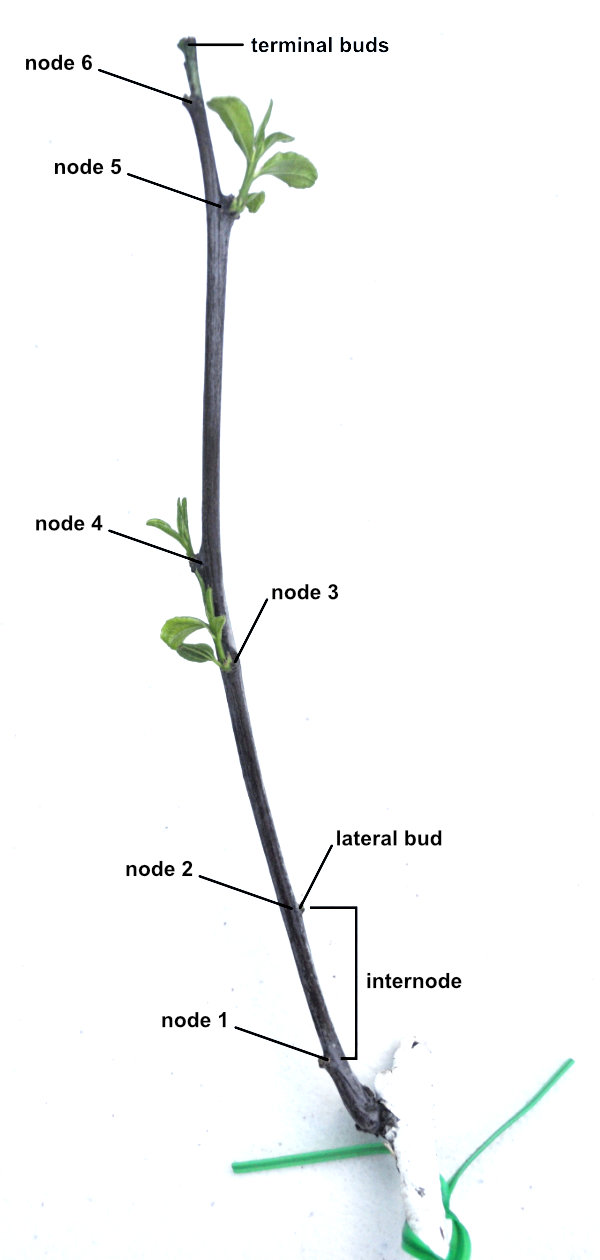 The Jujube Info and Care Reference Manual
The Jujube Info and Care Reference Manual- Jujube Tree Growth
- The Bud Types of a Jujube Tree
The Bud Types of a Jujube Tree
A ‘bud’, in botany, is a compact, undeveloped shoot which may develop into a twig/branch, leaf, or flower. The region in which buds are located is called a node, and the area between nodes is called an internode. Nodes are the points of attachment for branches, leaves and flowers. (Buds not arising from nodes, ie arising from unusual places, are called adventitious buds.)
The nodes in some species are very distinct — bamboo nodes, for example, are the thickened rings between the stem segments. The nodes in other species can be harder to find if leaves or branches aren’t present.
Nodes are easy to spot on young jujube wood, visible as single, slightly raised bumps which alternate (change sides) along a trunk and branches — and even easier to identify when there is green growth sprouting from them:

© Optimate Group Pty Ltd
The nodes tend to blend into the thickening branches of older wood until they are hardly visible at all:

© Optimate Group Pty Ltd
Just as jujube trees are atypical with their four different branch types, so too are they unusual with their buds.
Jujube trees have two bud types at each node: a main bud and a secondary bud.

© Optimate Group Pty Ltd
Each bud type in turn may be of strong or weak vigour, and it is this combination of type and vigour — as well as position on the tree! — which determines which of the four branch types develop.
These combinations are summarised below, but following chapters will go over each one in more detail:
Main Buds on Permanent Branches
Permanent branches are the ones that extend each year and which make up the shape of the tree.
Strong main buds on the ends of permanent branches (ie strong terminal main buds) produce the extension growth that make up the shape of the tree.
Weak main buds on the ends of permanent branches (ie weak terminal main buds) produce fruiting mother branches (which look more and more like pine cones the older they become).
Strong main buds along permanent branches (ie lateral strong main buds) are dormant, but the top-most one will break dormancy to produce a new permanent branch when the terminal strong main bud loses vigour.
Weak main buds along permanent branches (ie lateral weak main buds) produce fruiting mother branches.
Main Buds on Secondary Branches
Secondary branches develop from permanent branches and have a distinctive zigzag shape.
Main buds along secondary branches are dormant in the first year but produce fruiting mother branches from their second year on.
Main Buds on Fruiting Mother Branches
Fruiting mother branches are comprised of highly compressed bundles of shoots. These shoots do not have leaves, but contain many main and secondary buds. As a fruiting branch grows a little each year, this cluster of shoots also grows in size, and with each passing year resembles more and more a pine cone.
Fruiting mother branches are not to be confused with fruiting branchlets, the only branch type which produces fruit.
Very strong main buds on fruiting mother branches can break dormancy to produce a new permanent branch.
Strong main buds extend the fruiting mother branch by a millimetre or so each year.
Secondary Buds on Permanent Branches
Strong secondary buds on permanent branches produce secondary branches (the ones with the distinct zigzag shape).
Weak secondary buds on permanent branches produce fruiting branchlets (not to be confused with fruiting mother branches — the branchlets are the ones on which fruit grows).
Secondary Buds on Secondary Branches
All secondary buds on secondary branches produce fruiting branchlets (not to be confused with fruiting mother branches) the first year. The main buds then take over this role from the second year on.
Secondary Buds on Fruiting Mother Branches
All secondary buds on fruiting mother branches produce fruiting branchlets.
About the Author
BSc(Hons), U.Syd. - double major in biochemistry and microbiology, with honours in microbiology
PhD, U.Syd - soil microbiology
Stumbled into IT and publishing of all things.
Discovered jujube trees and realised that perhaps I should have been an agronomist...
So I combined all the above passions and interests into this website and its blog and manuals, on which I write about botany, soil chemistry, soil microbiology and biochemistry - and yes, jujubes too!
Please help me buy a plant if you found this article interesting or useful!